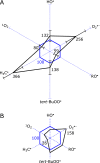Multiple free-radical scavenging (MULTIS) capacity in cattle serum
- PMID: 28163386
- PMCID: PMC5281526
- DOI: 10.3164/jcbn.15-142
Multiple free-radical scavenging (MULTIS) capacity in cattle serum
Abstract
Multiple free-radical scavenging (MULTIS) activity in cattle and human sera was evaluated with electron spin resonance spectroscopy. Scavenging rates against six active species, namely hydroxyl radical, superoxide anion, alkoxyl radical, alkylperoxyl radical, methyl radical, and singlet oxygen were quantified. The difference in the electron spin resonance signal intensity in the presence and absence of the serum was converted into the scavenging rates. Comparative MULTIS measurements were made in sera from eight beef cattle, three fetal calves and fifteen healthy human volunteers. Further, we determined the MULTIS value of albumin, the most abundant component in serum. MULTIS values in cattle sera indicated higher scavenging activity against most free radical species tested than human sera. In particular, cattle serum scavenging activities against superoxide and methyl radical were higher than human serum by 2.6 and 3.7 fold, respectively. In cattle serum, albumin appears to play a dominant role in MULTIS activity, but in human serum that is not the case. Previous data indicated that the abundance of uric acid in bovine blood is nearly 80% less than humans; however, this difference does not explain the deviation in MULTIS profile.
Keywords: MULTIS; antioxidants; cattle serum; multiple radical scavenging capacity; spin trapping.
Conflict of interest statement
No potential conflicts of interest were disclosed.
Figures




Similar articles
-
Heat treatments of ginger root modify but not diminish its antioxidant activity as measured with multiple free radical scavenging (MULTIS) method.J Clin Biochem Nutr. 2019 Mar;64(2):143-147. doi: 10.3164/jcbn.18-41. Epub 2018 Dec 5. J Clin Biochem Nutr. 2019. PMID: 30936626 Free PMC article.
-
A multiple free-radical scavenging (MULTIS) study on the antioxidant capacity of a neuroprotective drug, edaravone as compared with uric acid, glutathione, and trolox.Bioorg Med Chem Lett. 2014 Mar 1;24(5):1376-9. doi: 10.1016/j.bmcl.2014.01.045. Epub 2014 Jan 26. Bioorg Med Chem Lett. 2014. PMID: 24507926
-
Multiple free-radical scavenging capacity in serum.J Clin Biochem Nutr. 2012 Sep;51(2):117-21. doi: 10.3164/jcbn.11-113. Epub 2012 May 11. J Clin Biochem Nutr. 2012. PMID: 22962529 Free PMC article.
-
Antioxidant capacities in various animal sera as measured with multiple free-radical scavenging method.Bioorg Med Chem Lett. 2019 Aug 15;29(16):2145-2149. doi: 10.1016/j.bmcl.2019.06.057. Epub 2019 Jun 29. Bioorg Med Chem Lett. 2019. PMID: 31272792
-
Scavenging rate constants of hydrophilic antioxidants against multiple reactive oxygen species.J Clin Biochem Nutr. 2014 Mar;54(2):67-74. doi: 10.3164/jcbn.13-53. Epub 2014 Feb 21. J Clin Biochem Nutr. 2014. PMID: 24688213 Free PMC article.
Cited by
-
Heat treatments of ginger root modify but not diminish its antioxidant activity as measured with multiple free radical scavenging (MULTIS) method.J Clin Biochem Nutr. 2019 Mar;64(2):143-147. doi: 10.3164/jcbn.18-41. Epub 2018 Dec 5. J Clin Biochem Nutr. 2019. PMID: 30936626 Free PMC article.
-
Reagentless Sensing of Vancomycin Using an Indium Tin Oxide Electrode Grafted with Molecularly Imprinted Polymer including Ferrocenyl Group.Sensors (Basel). 2021 Dec 13;21(24):8338. doi: 10.3390/s21248338. Sensors (Basel). 2021. PMID: 34960432 Free PMC article.
-
Haematological and Chosen Biochemical Parameter Assessment of the Antioxidant System in Red Deer (Cervus Elaphus) Blood in Early and Late Pregnancy.J Vet Res. 2022 Aug 30;66(3):421-426. doi: 10.2478/jvetres-2022-0044. eCollection 2022 Sep. J Vet Res. 2022. PMID: 36349134 Free PMC article.
References
-
- Linster CL, Van Schaftingen E. Vitamin C. Biosynthesis, recycling and degeneration in mammals. FEBS J. 2007;274:1–22. - PubMed
-
- Domazou AS, Koppenol WH, Gebicki JM. Efficient repair of protein radicals by ascorbate. Free Radic Biol Med. 2009;46:1049–1057. - PubMed
-
- Kohri S, Fujii H, Oowada S, et al. An oxygen radical absorbance capacity-like assay that directly quantifies the antioxidant’s scavenging capacity against AAPH-derived free radicals. Anal Biochem. 2009;386:167–171. - PubMed
LinkOut - more resources
Full Text Sources
Other Literature Sources

